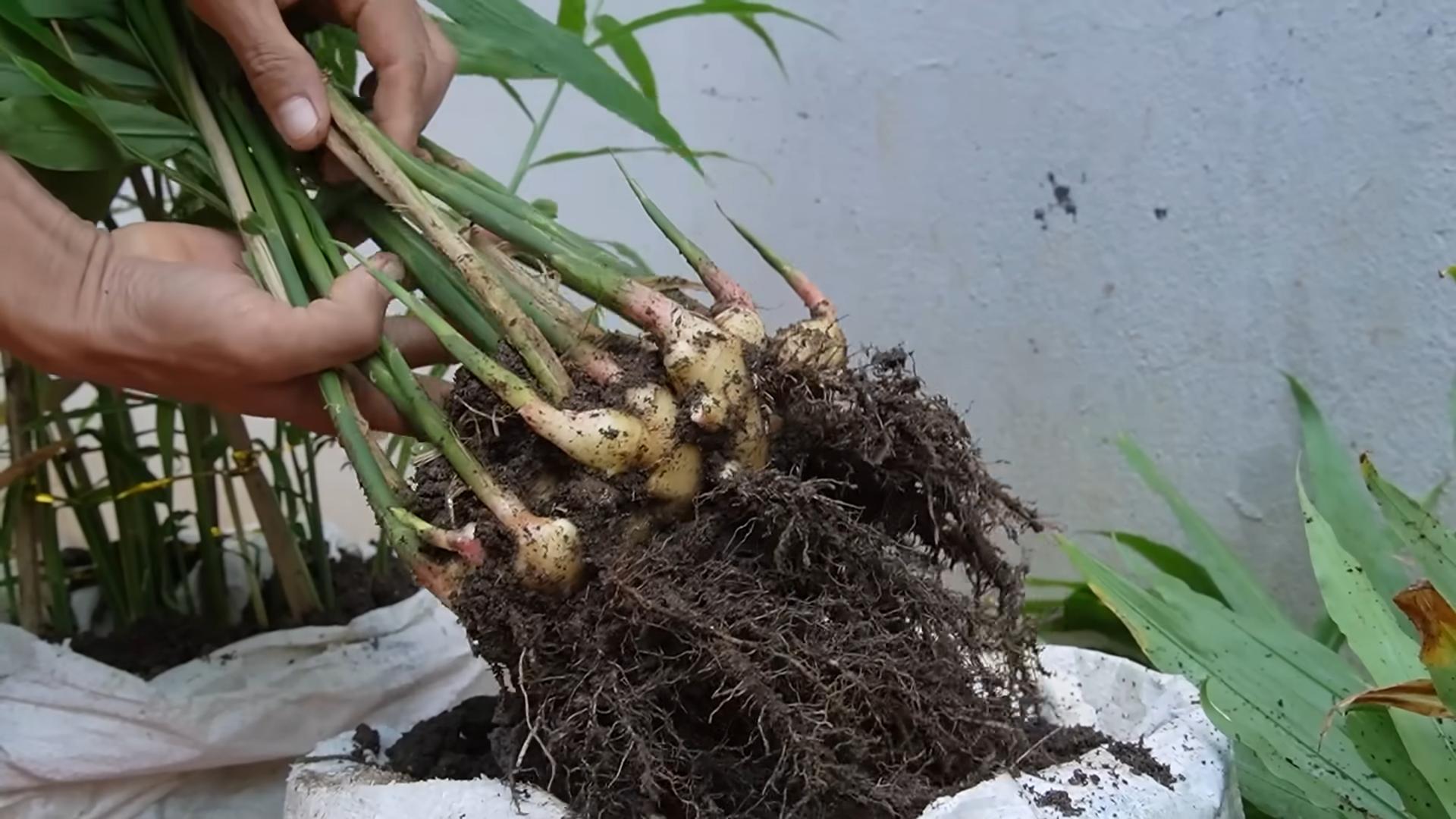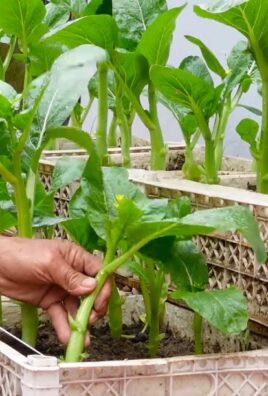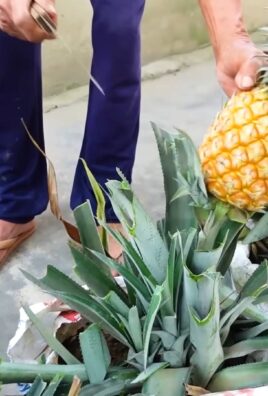Grow lettuce indoors? Absolutely! Imagine fresh, crisp lettuce available right at your fingertips, no matter the season. Forget those sad, wilted greens from the grocery store – we’re talking vibrant, flavorful lettuce grown with your own two hands, right in your home. For centuries, people have cultivated edible plants indoors, from ancient Roman orangeries to Victorian fern rooms. This practice wasn’t just about aesthetics; it was about extending the growing season and having access to fresh produce year-round.
Today, with concerns about food miles and the desire for healthier, more sustainable living, the need to grow lettuce indoors and other edibles has become even more pressing. This DIY guide will provide you with simple, effective tricks and hacks to transform any sunny corner into a thriving indoor lettuce garden. I’ll walk you through everything from choosing the right containers and soil to providing adequate light and water. Get ready to enjoy delicious, homegrown lettuce salads all year long!

Grow Your Own Salad: A Beginner’s Guide to Indoor Lettuce Gardening
Hey there, fellow plant enthusiasts! Ever dreamt of having fresh, crisp lettuce right at your fingertips, no matter the season? Well, dream no more! Growing lettuce indoors is surprisingly easy and rewarding. I’m going to walk you through everything you need to know to cultivate your own little indoor salad garden. Get ready to say goodbye to wilted supermarket lettuce and hello to homegrown goodness!
What You’ll Need: The Essentials for Indoor Lettuce Success
Before we dive into the nitty-gritty, let’s gather our supplies. Here’s a checklist of everything you’ll need to get started:
* Lettuce Seeds: Choose varieties that are well-suited for indoor growing. Loose-leaf varieties like Black Seeded Simpson, Salad Bowl, and Red Sails are excellent choices because they mature quickly and you can harvest leaves as needed.
* Growing Medium: You have a few options here. A good quality potting mix specifically formulated for vegetables is a great starting point. Alternatively, you can use a soilless mix like coco coir or peat moss combined with perlite or vermiculite for better drainage.
* Containers: Choose containers that are at least 6 inches deep to allow for adequate root growth. You can use individual pots, a long planter box, or even repurposed containers like plastic tubs (just make sure they have drainage holes!).
* Grow Lights: Lettuce needs plenty of light to thrive. If you don’t have a sunny windowsill that gets at least 6 hours of direct sunlight, you’ll need to invest in grow lights. Fluorescent shop lights or LED grow lights are both good options.
* Watering Can or Spray Bottle: For gentle watering.
* Optional: Seed Starting Tray and Dome: If you want to start your seeds indoors before transplanting them.
* Optional: Liquid Fertilizer: A balanced liquid fertilizer will help keep your lettuce plants healthy and productive.
Step-by-Step: From Seed to Salad Bowl
Alright, let’s get our hands dirty! Here’s a detailed guide to growing lettuce indoors:
Phase 1: Sowing the Seeds of Success
1. Prepare Your Containers: Fill your chosen containers with your selected growing medium, leaving about an inch of space at the top. Gently pat down the soil to create a level surface.
2. Sow the Seeds: Sprinkle the lettuce seeds evenly over the surface of the soil. Lettuce seeds are tiny, so don’t overcrowd them. A good rule of thumb is to space them about ½ inch apart.
3. Cover the Seeds: Lightly cover the seeds with a thin layer of soil (about ¼ inch). Lettuce seeds need light to germinate, so don’t bury them too deep.
4. Water Gently: Use a spray bottle or watering can with a gentle nozzle to moisten the soil. Be careful not to dislodge the seeds.
5. Create a Humid Environment (Optional): If you’re using a seed starting tray and dome, place the tray inside the dome to create a humid environment. This will help the seeds germinate. If you don’t have a dome, you can cover the containers with plastic wrap.
6. Place in a Warm Location: Place the containers in a warm location (around 60-70°F) with indirect light.
7. Keep the Soil Moist: Check the soil daily and water as needed to keep it consistently moist but not soggy.
Phase 2: Nurturing Your Seedlings
1. Germination: Lettuce seeds typically germinate within 7-14 days. Once the seedlings emerge, remove the dome or plastic wrap to allow for better air circulation.
2. Provide Adequate Light: If you’re using grow lights, position them about 4-6 inches above the seedlings. Adjust the height as the seedlings grow. If you’re using a sunny windowsill, rotate the containers regularly to ensure that the seedlings receive even light.
3. Thin the Seedlings: Once the seedlings have developed their first true leaves (the second set of leaves that appear after the initial seed leaves), thin them out to about 2-3 inches apart. This will give the remaining seedlings enough space to grow. Don’t throw away the thinned seedlings! You can transplant them to other containers or add them to your salad.
4. Water Regularly: Water the seedlings regularly, allowing the top inch of soil to dry out slightly between waterings. Avoid overwatering, as this can lead to root rot.
5. Fertilize (Optional): Once the seedlings are a few weeks old, you can start fertilizing them with a balanced liquid fertilizer diluted to half strength. Follow the instructions on the fertilizer label.
Phase 3: Harvesting Your Bountiful Crop
1. Harvesting: You can start harvesting lettuce leaves once they are about 4-6 inches long. For loose-leaf varieties, you can harvest individual leaves as needed, starting with the outer leaves. This is known as the “cut-and-come-again” method, and it allows you to harvest lettuce continuously for several weeks.
2. Harvesting Technique: Use scissors or a sharp knife to cut the leaves about an inch above the soil line.
3. Continue to Water and Fertilize: After harvesting, continue to water and fertilize your lettuce plants to encourage new growth.
4. Successive Planting: To ensure a continuous supply of lettuce, sow new seeds every few weeks.
Troubleshooting: Common Issues and Solutions
Even with the best care, you might encounter a few challenges along the way. Here are some common issues and how to address them:
* Leggy Seedlings: If your seedlings are tall and spindly, they’re likely not getting enough light. Move them closer to the grow lights or to a sunnier location.
* Yellowing Leaves: Yellowing leaves can be a sign of overwatering, underwatering, or nutrient deficiency. Check the soil moisture and adjust your watering accordingly. If the soil is consistently moist, you may be overwatering. If the soil is dry, you may need to water more frequently. You can also try fertilizing your plants with a balanced liquid fertilizer.
* Pests: Aphids and other pests can sometimes infest indoor lettuce plants. Inspect your plants regularly and treat any infestations promptly. You can use insecticidal soap or neem oil to control pests.
* Bolting: Bolting is when lettuce plants start to produce flowers and become bitter. This is usually caused by hot weather or stress. To prevent bolting, keep your lettuce plants cool and well-watered. If your plants start to bolt, you can still harvest the leaves, but they may not taste as good.
Choosing the Right Lettuce Variety
Not all lettuce varieties are created equal, especially when it comes to indoor growing. Here are some of my favorite varieties for indoor cultivation:
* Black Seeded Simpson: A classic loose-leaf variety that’s easy to grow and has a mild flavor.
* Salad Bowl: Another popular loose-leaf variety with frilly leaves and a slightly sweet taste.
* Red Sails: A beautiful loose-leaf variety with reddish-bronze leaves. It adds a pop of color to your salad.
* Tom Thumb: A compact butterhead lettuce that’s perfect for growing in small containers.
* Little Gem: A small romaine lettuce that’s crisp and flavorful.
Optimizing Your Indoor Lettuce Garden
Want to take your indoor lettuce garden to the next level? Here are a few tips to help you maximize your yield and enjoy even more delicious homegrown lettuce:
* Use a Timer for Your Grow Lights: Set your grow lights on a timer to ensure that your lettuce plants receive consistent light. A good rule of thumb is to provide 12-14 hours of light per day.
* Provide Good Air Circulation: Good air circulation will help prevent fungal diseases. You can use a small fan to circulate the air around your plants.
* Monitor Soil pH: Lettuce prefers a slightly acidic soil pH (around 6.0-6.5). You can use a soil pH meter to monitor the pH of your soil and adjust it as needed.
* Rotate Your Crops: To prevent soil depletion, rotate your crops regularly. This means planting different types of plants in the same containers each season.
* Experiment with Different Varieties: Don’t be afraid to experiment with different lettuce varieties to find the ones that you like best and that grow well in your indoor environment.
Enjoying Your Homegrown Harvest
Now for the best part – enjoying the fruits (or rather, leaves!) of your labor. There’s nothing quite like the taste of fresh, homegrown lettuce. Use it in salads, sandwiches, wraps, or as a garnish for your favorite dishes.
Growing lettuce indoors is a fun and rewarding experience that anyone can do. With a little bit of effort and the right supplies, you can have a continuous supply of fresh, delicious lettuce all year round. So, what are

Conclusion
So, there you have it! Growing lettuce indoors is not only achievable but also incredibly rewarding. Imagine fresh, crisp lettuce leaves available at your fingertips, regardless of the season. No more last-minute grocery store runs for that essential salad ingredient, and no more wilted, sad-looking lettuce from the back of the fridge. This DIY approach to fresh produce is a game-changer for anyone looking to embrace a more sustainable and convenient lifestyle.
The beauty of this method lies in its simplicity and adaptability. You don’t need a sprawling garden or specialized equipment. A sunny windowsill, a grow light, and a little bit of care are all it takes to cultivate your own personal lettuce patch. Think of the possibilities! You can experiment with different varieties, from the delicate butter lettuce to the robust romaine, tailoring your harvest to your specific tastes and culinary needs.
Beyond the convenience and freshness, growing your own lettuce indoors offers a unique connection to your food. You’ll witness the entire life cycle of the plant, from tiny seed to vibrant, edible leaves. This process can be incredibly therapeutic and educational, especially for children. It’s a fantastic way to teach them about where their food comes from and the importance of sustainable practices.
Why is this a must-try? Because it empowers you to take control of your food supply, reduces your reliance on commercially grown produce, and provides you with a constant source of fresh, healthy greens. It’s a small step towards a more self-sufficient and environmentally conscious lifestyle.
Variations to consider:
* Hydroponics: For a more advanced approach, explore hydroponic systems. These soilless setups can significantly increase your lettuce yield and reduce the risk of soilborne diseases.
* Vertical Gardening: Maximize your space by using vertical planters or stacked containers. This is especially useful for those with limited windowsill space.
* Succession Planting: Plant new seeds every few weeks to ensure a continuous harvest throughout the year. This will prevent you from being overwhelmed with lettuce all at once and ensure a steady supply.
* Companion Planting: Consider planting herbs like basil or chives alongside your lettuce. These herbs can help deter pests and enhance the flavor of your lettuce.
We wholeheartedly encourage you to give this DIY trick a try. It’s a simple, affordable, and incredibly satisfying project that will transform the way you think about fresh produce. Don’t be afraid to experiment, learn from your mistakes, and adapt the process to suit your specific needs and preferences.
Most importantly, we want to hear about your experiences! Share your successes, your challenges, and your tips for growing lettuce indoors in the comments below. Let’s create a community of indoor gardeners and inspire others to embrace the joys of homegrown lettuce. Your insights could be invaluable to someone just starting out. So, grab your seeds, prepare your soil, and get ready to enjoy the freshest lettuce you’ve ever tasted! Let us know how your indoor lettuce garden grows!
Frequently Asked Questions (FAQ)
What is the best type of lettuce to grow indoors?
The best types of lettuce to grow indoors are loose-leaf varieties like butter lettuce, romaine lettuce, and leaf lettuce. These varieties are relatively quick to mature and can be harvested continuously, making them ideal for indoor growing. Head lettuce varieties, such as iceberg, can be more challenging to grow indoors due to their larger size and longer maturation time. However, with proper care and adequate space, they can still be successfully cultivated. Consider starting with a mix of different loose-leaf varieties to experiment and find your favorites.
How much light does indoor lettuce need?
Lettuce requires at least 6 hours of direct sunlight per day to thrive. If you don’t have a sunny windowsill, you can supplement with grow lights. LED grow lights are an energy-efficient option and provide the full spectrum of light that lettuce needs for opt
So, there you have it! Growing lettuce indoors is not only achievable but also incredibly rewarding. Imagine fresh, crisp lettuce leaves available at your fingertips, regardless of the season. No more last-minute grocery store runs for that essential salad ingredient, and no more wilted, sad-looking lettuce from the back of the fridge. This DIY approach to fresh produce is a game-changer for anyone looking to embrace a more sustainable and convenient lifestyle.
The beauty of this method lies in its simplicity and adaptability. You don’t need a sprawling garden or specialized equipment. A sunny windowsill, a grow light, and a little bit of care are all it takes to cultivate your own personal lettuce patch. Think of the possibilities! You can experiment with different varieties, from the delicate butter lettuce to the robust romaine, tailoring your harvest to your specific tastes and culinary needs.
Beyond the convenience and freshness, growing your own lettuce indoors offers a unique connection to your food. You’ll witness the entire life cycle of the plant, from tiny seed to vibrant, edible leaves. This process can be incredibly therapeutic and educational, especially for children. It’s a fantastic way to teach them about where their food comes from and the importance of sustainable practices.
Why is this a must-try? Because it empowers you to take control of your food supply, reduces your reliance on commercially grown produce, and provides you with a constant source of fresh, healthy greens. It’s a small step towards a more self-sufficient and environmentally conscious lifestyle.
Variations to consider:
* Hydroponics: For a more advanced approach, explore hydroponic systems. These soilless setups can significantly increase your lettuce yield and reduce the risk of soilborne diseases.
* Vertical Gardening: Maximize your space by using vertical planters or stacked containers. This is especially useful for those with limited windowsill space.
* Succession Planting: Plant new seeds every few weeks to ensure a continuous harvest throughout the year. This will prevent you from being overwhelmed with lettuce all at once and ensure a steady supply.
* Companion Planting: Consider planting herbs like basil or chives alongside your lettuce. These herbs can help deter pests and enhance the flavor of your lettuce.
We wholeheartedly encourage you to give this DIY trick a try. It’s a simple, affordable, and incredibly satisfying project that will transform the way you think about fresh produce. Don’t be afraid to experiment, learn from your mistakes, and adapt the process to suit your specific needs and preferences.
Most importantly, we want to hear about your experiences! Share your successes, your challenges, and your tips for growing lettuce indoors in the comments below. Let’s create a community of indoor gardeners and inspire others to embrace the joys of homegrown lettuce. Your insights could be invaluable to someone just starting out. So, grab your seeds, prepare your soil, and get ready to enjoy the freshest lettuce you’ve ever tasted! Let us know how your indoor lettuce garden grows!
Frequently Asked Questions (FAQ)
What is the best type of lettuce to grow indoors?
The best types of lettuce to grow indoors are loose-leaf varieties like butter lettuce, romaine lettuce, and leaf lettuce. These varieties are relatively quick to mature and can be harvested continuously, making them ideal for indoor growing. Head lettuce varieties, such as iceberg, can be more challenging to grow indoors due to their larger size and longer maturation time. However, with proper care and adequate space, they can still be successfully cultivated. Consider starting with a mix of different loose-leaf varieties to experiment and find your favorites.
How much light does indoor lettuce need?
Lettuce requires at least 6 hours of direct sunlight per day to thrive. If you don’t have a sunny windowsill, you can supplement with grow lights. LED grow lights are an energy-efficient option and provide the full spectrum of light that lettuce needs for optimal growth. Position the grow lights a few inches above the lettuce plants and adjust the height as they grow. Insufficient light can result in leggy, pale lettuce with a bitter taste.
What type of soil should I use for growing lettuce indoors?
Use a well-draining potting mix that is rich in organic matter. Avoid using garden soil, as it can be too heavy and may contain pests or diseases. A good potting mix will provide adequate drainage and aeration, which are essential for healthy lettuce growth. You can also amend your potting mix with compost or other organic materials to improve its fertility.
How often should I water my indoor lettuce?
Water your lettuce regularly, keeping the soil consistently moist but not waterlogged. Overwatering can lead to root rot, while underwatering can cause the lettuce to wilt and dry out. Check the soil moisture level daily and water when the top inch of soil feels dry to the touch. Use a watering can or spray bottle to gently water the lettuce plants, avoiding wetting the leaves as much as possible to prevent fungal diseases.
What is the ideal temperature for growing lettuce indoors?
Lettuce prefers cool temperatures, ideally between 60°F and 70°F (15°C and 21°C). Avoid placing your lettuce plants near heat sources, such as radiators or vents, as excessive heat can cause them to bolt (go to seed) and become bitter. If your indoor environment is too warm, you can try placing your lettuce plants in a cooler location or using a fan to circulate the air.
How do I harvest my indoor lettuce?
You can begin harvesting your lettuce when the leaves are about 4-6 inches long. Harvest the outer leaves first, leaving the inner leaves to continue growing. This method, known as “cut-and-come-again,” allows you to harvest lettuce continuously over several weeks. Use scissors or a sharp knife to cut the leaves close to the base of the plant.
How do I prevent pests and diseases from affecting my indoor lettuce?
Inspect your lettuce plants regularly for signs of pests or diseases. Common pests that can affect indoor lettuce include aphids, spider mites, and whiteflies. You can control these pests by spraying your lettuce plants with insecticidal soap or neem oil. To prevent fungal diseases, ensure good air circulation and avoid overwatering. Remove any yellowing or diseased leaves promptly to prevent the spread of disease.
Can I grow lettuce indoors year-round?
Yes, you can grow lettuce indoors year-round, provided you have adequate light and temperature control. With the help of grow lights, you can supplement natural sunlight during the winter months. By maintaining a consistent temperature and providing regular watering and fertilization, you can enjoy fresh lettuce from your indoor garden all year long.
How often should I fertilize my indoor lettuce?
Fertilize your lettuce every 2-3 weeks with a balanced liquid fertilizer. Follow the instructions on the fertilizer label for proper dilution. Avoid over-fertilizing, as this can lead to excessive leaf growth and a bitter taste. You can also amend your potting mix with compost or other organic materials to provide a slow-release source of nutrients.
What are some common problems when growing lettuce indoors and how can I fix them?
Some common problems include:
* Leggy growth: Insufficient light. Provide more light with grow lights or move to a sunnier location.
* Yellowing leaves: Overwatering or nutrient deficiency. Adjust watering habits and fertilize with a balanced fertilizer.
* Bitter taste: Bolting due to high temperatures or stress. Maintain cool temperatures and provide adequate watering.
* Pests: Inspect regularly and treat with insecticidal soap or neem oil.
By addressing these common problems promptly, you can ensure a healthy and productive indoor lettuce garden.




Leave a Comment